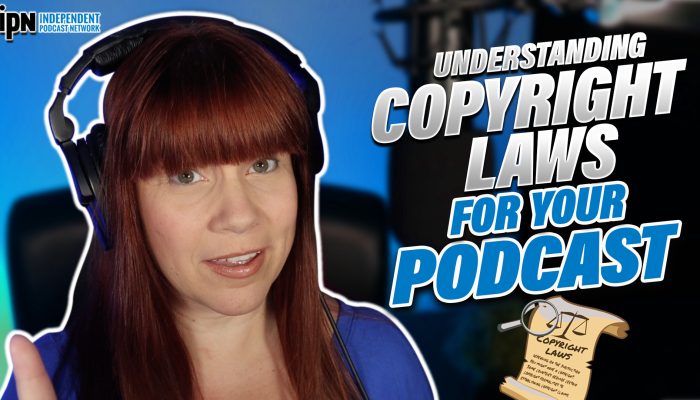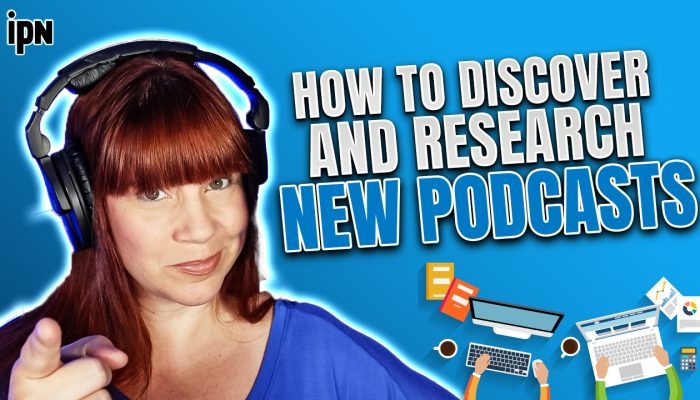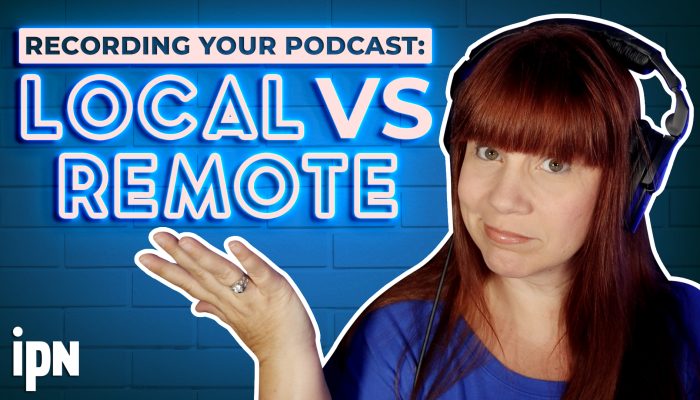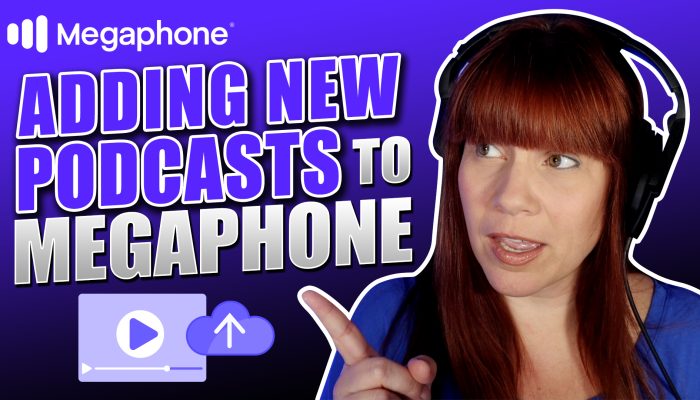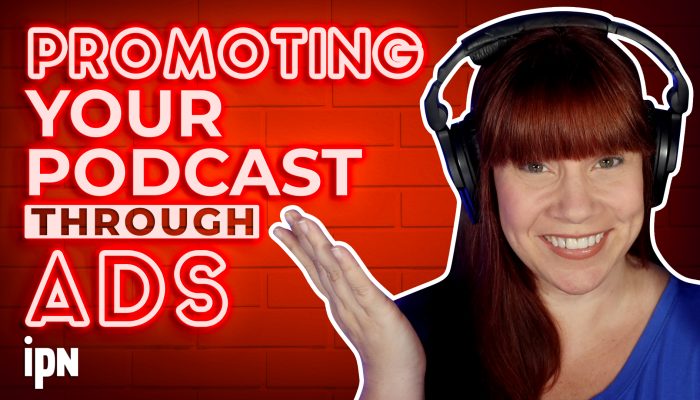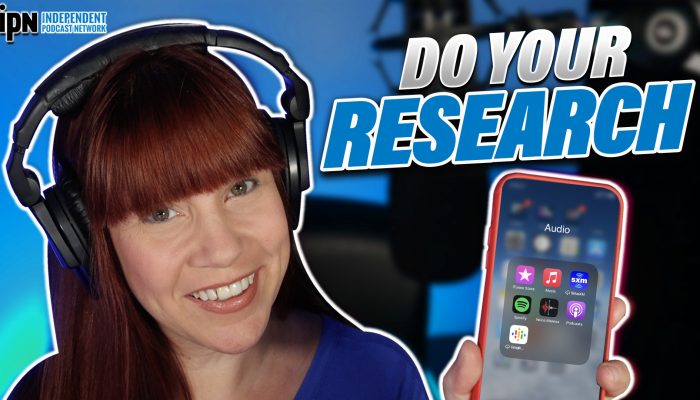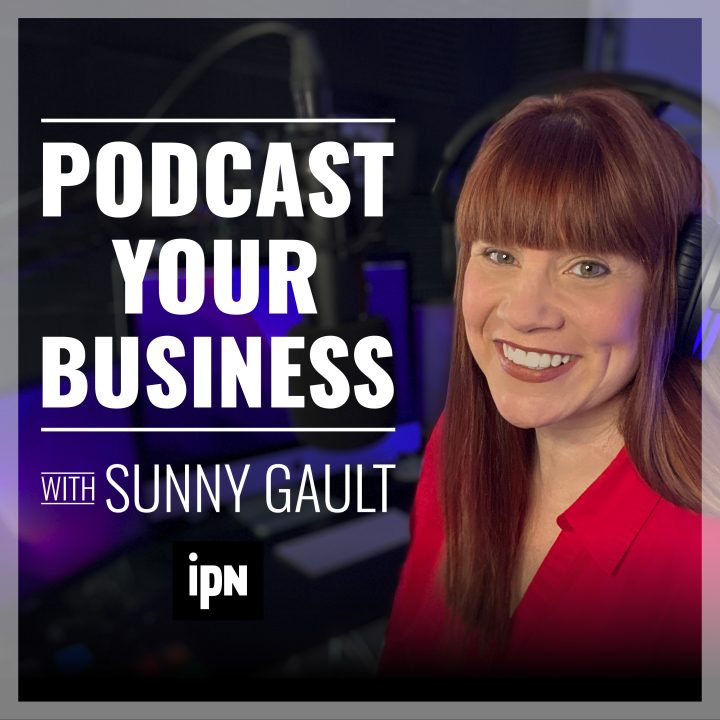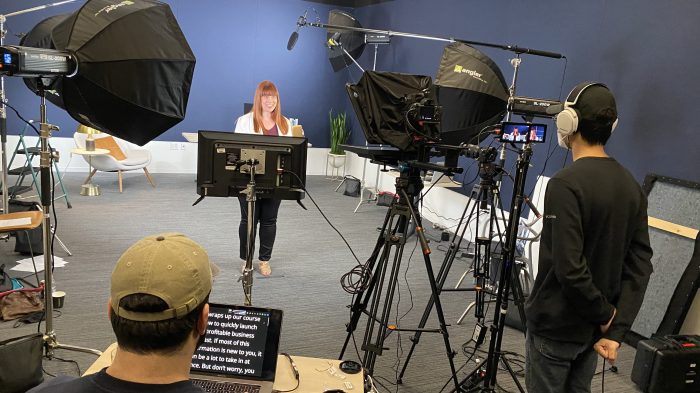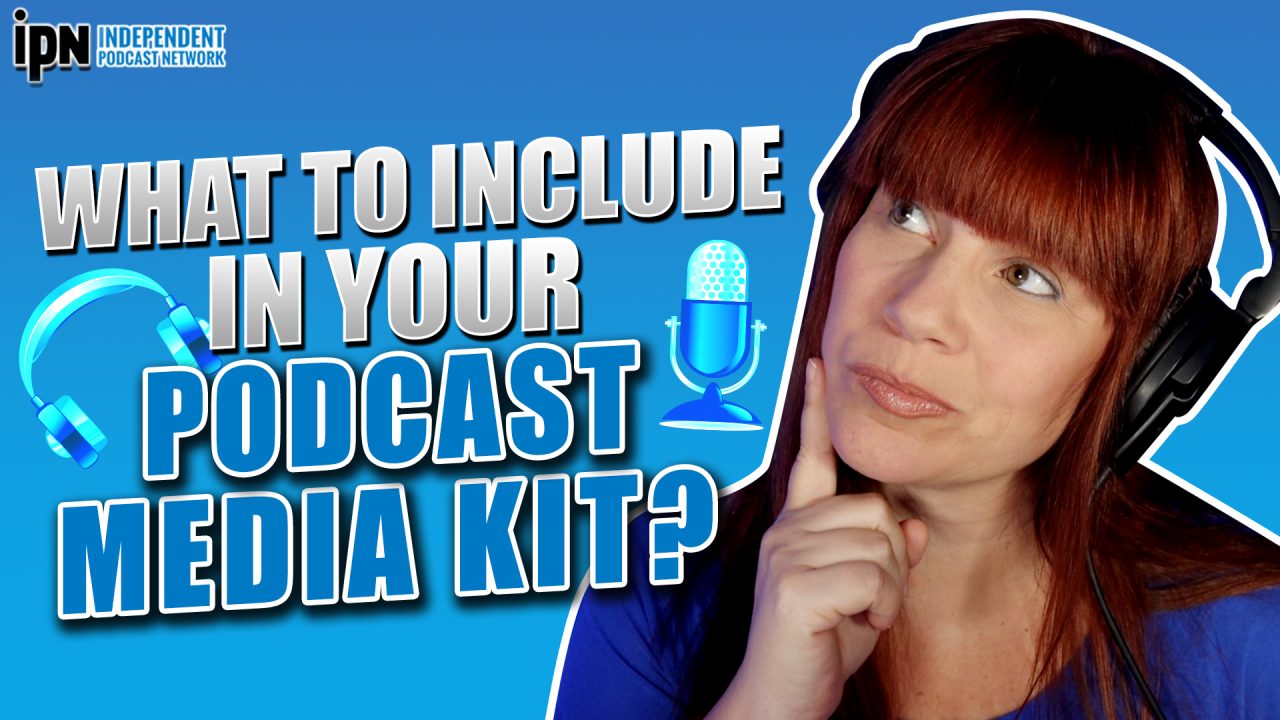
Book great Guests and secure podcast advertisers
If you’re serious about getting the word out about your podcast- then you need to create a media kit. If you do it right, your media kit can make a great first impression of your podcast. It can help you get amazing guests on your show and can even do some of the selling for you if you’re looking for advertisers. But you need to include the right information, and you don’t want to overdo it. So, let’s talk about what to include in your podcast media kit.
Here’s what we’re talking about today…
- What is a media kit and why is it important?
- What should you include in your media kit?
- What should you do with your media kit?
free podcast media kit template in canva
Click the link below to download this modified podcast media kit template. It has everything you need to impress potential guests and advertisers. Need a media kit for a group of podcasts? Grab that template here.

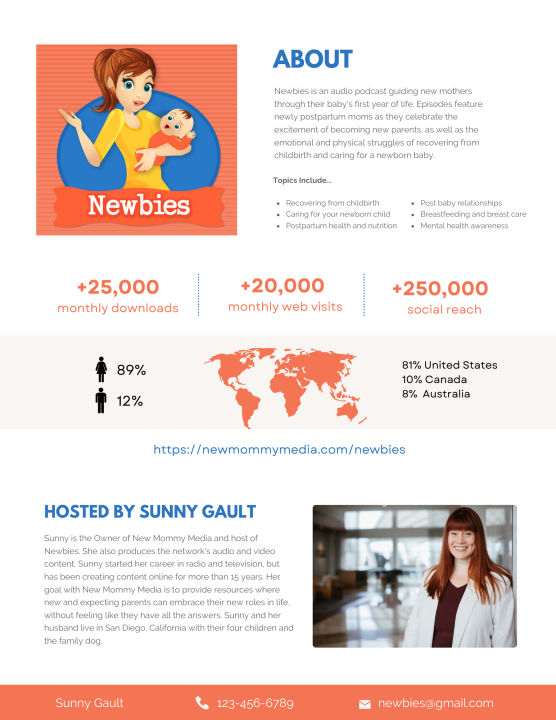
Episode Transcript
0:02
If you’re serious about getting the word out about your podcast, then you need to create a media kit. If you do it right, your media kit can make a great first impression for your podcast. And it can help you get amazing guests on your show. It can even do some of the selling for you if you’re looking for advertisers. But you need to include the right information. And you don’t want to overdo it. So let’s talk about what to include in your podcast media kit. Take it away Mr. radio man. Podcast Your Business.
0:40
Hey you! Welcome to Podcast Your Business. I’m Sunny Gault. I’m a podcast coach and mentor. And I’ve been podcasting for the last 17 years give or take, I think I might be at 18. Now, I don’t know, you lose track after a while. I am the founder and CEO of Independent Podcast Network. And you can check us out https://independentpodcast.network, we’ve got a ton of great resources for you everything is absolutely free, because that is a passion of mine. And that is helping podcasters regardless of wherever you’re at, we’ve got free courses on there on how to podcast, free blog posts, more great podcast episodes like this. Today, I am here to help you create amazing podcasts. And with this show, we specifically focus on podcast for your business. However, if your podcast is not related to your business, you’re still going to benefit from the content. So how do we create these amazing podcasts? We do this by mastering the five P’s of podcasting. Right. So what are the five P’s of podcasting? This is something a concept that I created when I did my first podcast course, which I think was like in 2020, when everyone was like, on lockdown and didn’t know what to do in their house, I’m like, I’m going to create a whole course on how to podcast and I came up with the five Ps, because when I think back on my podcasting journey, and with the shows that were successful, because let’s admit, sometimes you have some duds, what was it that really made those show successful, and I came up with five P’s, we’ve got prep, plan, produce, promote, and profit. So if you want to have a successful show that leads to more money in your wallet, and for those of you who have created a podcast for your business, yes, you do need to make money from this, it somehow has to benefit your business, then you need to master these five P’s. When we talk about PrEP, we’re talking about why you’re even starting a podcast, if someone tells you you need to start a podcast is you know, do you just have this feeling that you need to get something out there? Are you really ready for this plan is the look and feel for your podcast. So it’s after you’ve said yes, I’m going to create a podcast? Well, what is the format for that? How often you’re going to release episodes, things like that produce is the actual creation of the content, whether you’re doing audio or video, how do you do it tips and tricks for making it look and sound great. Promote, of course, is telling everyone about it, because you could have the most amazing podcast in the world. But if no one knows about it, it’s kind of like it doesn’t exist. And then profits, I already really emphasize this, especially for those of you who are podcasting, and it’s related to your business, you have to make money somehow, it has to come back to benefit your business, maybe that’s more clients, maybe that is connecting you with other thought leaders in your space, whatever it is, maybe you’ve got some other stuff going on. And you can add this to a package and, you know, charge more money for that. So there’s a lot of different ways to do that. Mr. radio man, what are we talking about today? Promote.
3:45
That’s right. When we’re talking about promoting our podcast, the media kit, it kind of just goes hand in hand, you’re not really going to create a media kit if you don’t want to promote your podcast. Because let’s face it, you can’t always be there in person to make the most beautiful, awesome, perfect pitch to someone about your show, which is why we have media kits, which by the way, they’re not just called media kits, there’s like 15 different names for them. Sometimes you’ll hear people call them press kits, or if it’s a shortened more condensed version of a media kit, you’ll hear one sheet, and I’ve created pretty much all of them guys. So I’ve created them for individual podcast groups of podcast networks that have many, many podcasts. And this is just something that you’re going to need. If you’re serious about your podcast, you need to create a media kit, and you need to do it stat. Okay, which is why we’re doing today’s episode. Here’s what we’re going to talk about. I kept this as simple as possible because I really want you guys to grab what you need out of this and create your media kit. So the first question is what is a media kit and why do we think this is so important? The next question is, what should you include in your media kit? So that ties into the title of today’s episode, right? And I’m just going to share with you what I’ve learned over the years because I include certain things, depending on my goal for the media kit, my goal for the podcast or for the network, or whatever it is I’m working on. And the last question is, okay, so let’s say you create this beautiful media kit. It’s awesome and amazing. Now, what do you do with it? How can you actually use it? And you might be surprised by some of my answers. So we’re gonna get started. And we’re going to talk about all this great content right after this quick break.
5:25
So what in the world is a media kit? And why is this media kit so important? Your media kit is basically think of it as your podcast resume. So you have your resume that you have to find jobs and things like that, right? Well, your podcast needs a resume, too, for many different reasons. You know, maybe you’re trying to find guests for your show, or advertisers, or, you know, just tell someone about your podcast, it’s much easier to have some sort of media kit to give to people think of it as a snapshot of your show, or maybe like an elaborate business card, although it has a, it can have at least a lot of content in it. But you’re basically trying to put your best foot forward, it’s like you have a first date. Right? And you’re like, here’s my podcast, and how amazing it is, you’re gonna give someone your media kit. And by the way, having a media kit really shows that you’re committed to your podcast, if you don’t have it, for example, let’s say you’re trying to reach out to advertisers. And you don’t even have a media kit, they’re going to look at you like you’ve got like, you know, four eyes or something like that. Because this is standard in the industry. And it can just help in so many different ways. So people that have a MIDI kit, I know, I definitely take those shows a little bit more seriously, especially if they’re asking for money, then people that haven’t even gotten that far. Again, that’s why we’re doing today’s episode. And it does a lot of things for you. So I don’t recommend you just hand this off to somebody else. Even if you had the funds to do that. At least you can have someone else design it if you want, but at least go through the process of getting the information for the media kit and really thinking about that. Because I’m telling you, if there are any holes or weak points in your marketing strategy, and who you are as a podcast, and who you reach out to, you are going to find out really quickly by creating a media kit, because it’s all about your brand. So if you can’t even answer these questions, then how are other people going to know who you are and what you represent. So do some of the homework yourself. Like I said, if you need to hand off the design of it, that’s okay. I’ve done that in the past as well. And I’m just going to give you a heads up, it’s going to take a little bit of effort, you really need to think about this. But that’s okay. Because this is your brand. This is your podcast. And you may be using this to try to attract advertisers. And in that case, you know, this is your money. This is money we’re talking about. So take some time. Okay, so that’s why it’s important.
7:57
What should you include in your media kit. So I’m gonna run through some of the items that I highly recommend. I’ll go through the most important things first. And then there’s a couple things that you could have, you could not have religious depending on the stage your podcast is and what you’re trying to accomplish with your media kit. But here are some standards. You ready? You need your podcast artwork. Yes, your podcast is online. And you may have a website for your podcast as well. But we’re talking about something that can stand alone, that you can send to someone where maybe they don’t have internet access right now maybe they’re flying, maybe they’re doing something like that. You need your podcast artwork. And then next to that I do recommend some sort of summary of what your show is about. Can they find us online? Yes, they can. Don’t worry about that, though. And then if you want to break it down a little bit more, you can have titles of the episodes, maybe some of your most popular episodes that you’ve done in the past. If you don’t want to get that specific, you can you just talk about maybe list some of the topics that you’ve talked about in the past, and what’s been popular, you can also highlight significant guests that you’ve had on so if you’ve had some celebrities or something like that, or people that are just really well known thought leaders in your industry, that you think would be impressive to people looking at your media kit, go ahead and include it nothing wrong with that. I would also recommend since podcasts are so specific, meaning a lot of times people will listen to a podcast because they liked the host. I do recommend that you haven’t it can be small, but a little section that has the bio for the host and if you want to take it one step further. Then I recommend you have a photo as well. So it can be small, don’t have a ton of information guys keep this as simple as possible. A short, maybe three or four sentence paragraph that is it. But it’s nice to know now if you’ve got if you’ve got a lot of hosts for show, maybe skip this section. Okay, or maybe you’ve got a main host and, you know, secondary hosts or you know, whatever, keep it simple, but especially if you only have one, and if it ties back into your business, things like that, I’m always a big advocate of having your photo and your bio, because you never know what this could lead, you could send your media kit to someone, and they can be like, Well, I’m not really interested in the show. But hey, I saw on her bio, that she’s done XYZ. And we really need a speaker to talk about XYZ, so you never know where this is gonna go.
10:28
Next, you need some stats and metrics. And don’t freak out. If you have a brand new show, and you don’t have all of this information. I remember I was creating a media kit, one point it was more like one sheet because it was very, very simple. It literally was one sheet. That’s why you call it a one sheet. And I didn’t have these kinds of stats. But what I included was what I thought the demographics were going to be the types of people I thought we were going to reach out to. And I made it very clear, right, the show hasn’t launched yet. But this is more like your avatar, these are the people that we’re trying to reach out to this is our target demographic. So if you need to switch it in the beginning, because you don’t have those metrics, that’s fine. If your show has been up and running for a little bit, here are some stats and metrics you may want to include. You have your downloads for your episodes, right. And depending on if you are doing dynamic ad insertion, or if you’re just baking in the ads into your show, you may want to include your downloads per month. And that would be across all of your episodes for that podcast, or, and or your downloads per episode. Because if you’re not using dynamic ad insertion, then you’re probably just recording the ad directly into your show. And in that case, it’s only going to appear on that one episode. So people want to know how many downloads, on average does each podcast episode get, and to come up with those numbers, at least for the per episode, Count 30 days out from when you launch the episode, because it’s going to continue to accumulate numbers, right. So we really just measure for that first month, after you release. You can also include numbers of subscribers, I don’t usually do this. But if you have some of those numbers, and you want to include it, it’s really difficult with podcasts, right? Because you’ve got multiple platforms that you’re working with. But let’s say you had a YouTube channel, right, so you were doing some videos on YouTube, maybe you want to include that number as well, website visits. I’m a big advocate of your website, having your podcast on it. So maybe it’s separate. So you have a separate website just for your podcast. But if this is tied into your business, do not do that have your podcast, I talk about this a lot in the main navigation, say podcast on your business website, and then have a whole section that is just dedicated to your podcast. So if you can get a little more granular, and find out what the website visits are to that section of your website, or again, if you do have a completely separate website for your podcast, it’s easier to come up with those numbers. But you may want include some information like that, because if you’re offering any kind of information, whether there’s display ads, or let’s say, you know, the guests that have that are coming on your show, you have pages for them on their website, see, it’s all about their exposure when you’re trying to outreach to guests, right? So it might look impressive, if you say, Hey, we have x amount of people that visit our website every day, every week, every month. And that’s just more exposure for them. If you have an email, list your email subscribers that can be helpful. And this kind of ties into what I was talking about earlier with YouTube, but any kind of social media reach, so your followers your total reach. And there’s some really cool graphics and stuff that are available online. I’ll get to that in a little bit. Because there’s some amazing templates that can display that really well. Alright, so those are your stats and metrics. If you don’t have them yet, don’t freak out. But once you get them, you know your media kit is really a work in progress. So as you get some of this, it’s okay to add a few things here and there until you have some numbers that a little bit more impressive. So that stats and metrics.
14:17
If you are going into sponsorship or advertising, and you’re using your media kit to get sponsors or advertisers, you can include some of those opportunities in your media kit. I have done it where it is a couple pages, right because maybe I offer things that are Alain cart, and then I have packages that I offer as well. So you could do it that way. I’ve seen it as well where people don’t include all of the sponsorship or advertising information, but they include the types of advertisers they’re working with or maybe the names of previous advertisers they’ve had. So it really depends on how long and detailed you want your media kit to be. I’ve done it both ways and I can show you guys some examples for that. The thing to keep in mind, if you are going to actually list out advertising options for sponsorship options, I would do two different versions, I would do one with pricing and one without. And my recommendation is to include this on your podcasts website or on your business website and in the podcast section, include the one without pricing on your website. So you only give out your pricing to people that have outreach to you, because then you’ve got their contact information. And you can kind of go back and forth, it’s more of a personal relationship. If, if all of your information is online, including your prices, it can sometimes be a missed opportunity, because they’ll see some prices. And then they’ll just think, oh, that’s totally out of my reach. And maybe it is, and maybe if you’re very firm on your prices, maybe you want that information out there. But if you think you can be more flexible, and you want to try to create some relationships with these people, essentially forcing them to outreach to you to connect with you via email or whatever. And then you can say, hey, I have the prices, I can send you the prices now. And then you can go back and forth. So that’s up to you. That’s actually what I do. So I have on my website for my parenting shows, I have a media kit that does not list the prices. And then when people reach out to me, and I’ve got their email, so I can ask them questions and go back and forth, create a conversation, that is when I send them the media kit with the pricing.
16:32
Okay. Some other things that you can include that aren’t mandatory, but might be kind of fun. If you have any photos from your podcast recordings, and I know sometimes that’s hard to get. But it just puts the people kind of in the mindset of what it’s like when you record. So maybe that’s you behind a microphone, or if you’re recording with a group of people that can be kind of fun as well, if you have anything that kind of draws them in. So for my parenting shows, when we first started doing those shows, we recorded in person. And so I have these amazing photos of a bunch of moms and sometimes dads around these microphones holding babies as they’re recording these podcast episodes. And I’m telling you what it is awesome to include in media kits. And so if you’ve got those kinds of things lying around, please include them, okay, it just really shows that you’re into podcasting and kind of puts them in, you know, that whole frame of mind, you can also include testimonials. And the easiest way to do this is to grab your good reviews, from Apple podcast, Spotify, wherever people are leaving comments. So you can grab some of those and included in there. If your podcast has won any awards, which I’m not a big award person for podcasts. But if you are on some sort of top, whatever list, you know, in this podcast category, whatever you can come up with that can help you and make your podcast stand out. That’s a good idea. Now one thing that is absolutely mandatory, and honestly should go on every single page of your media kit is your contact information. Do not make people search for that don’t make it hard for them to reach out to you. So include whatever information you feel comfortable with, because this could be shared with people and you don’t even know it. So if you don’t want, you know, your personal cell phone out there, don’t include it. But include the email that people can reach out to you perhaps a phone number and your name, at the very least you don’t need addresses, nobody’s sending anything via snail mail. So don’t worry about that. And if it gets to a point where you need a contract, then you can give them your address. So that’s what I would include, you know, and how much you include. And you know, that’s that’s up to you. It’s up to how many sheets you want this to be.
18:50
Here are some general tips that I have for you guys. And again, I’ve been doing these media kits and one sheets for a really long time, less is more, you may have a ton of information that you want to include. But this is your baby, you love your baby. Understand that this is not everybody else’s baby. And you may be talking to or the person that is downloading your media kit or that you’re interacting with may be looking at 50 podcasts that day to determine if they want to advertise on any of them. So keep it short and sweet. They can always come back and ask you for more information. So less is more. Keep it simple. And here’s another really good tip. Don’t do weird formats or weird sizes. Because sometimes the people want to print out the media kit and show it to somebody. So keep it standard. Whether you do I mean I actually think it’s better to just do vertical eight and a half by 11 letter size. Sometimes I’ve done more of a horizontal look but that same size. I still don’t recommend that I went back to eight and a half by 11. You know just do it. How you would print out a normal piece of paper, because that’s how most people are going to be printing. Again, we’re just trying to keep it as simple as possible. And finally, and I mentioned this a little bit earlier, but understand that this is just a starting point, you have to continually update your media kit. So that may be updating your stats, or maybe your advertising options change, or you have a new gas that is amazing that you want to add, this is a work in progress. So make sure you update it as frequently as possible. And the last thing I wanted to touch on is, why are we doing all of this? And what, what should we do? So let’s say we create this beautiful media kit, what do we do with it now, my number one recommendation is to add it to your podcast website, or your business website, whichever, you know, you’ve however, you have things set up. I mentioned this earlier, but have it included there, okay, on the main page. So if it’s if you’ve got a main podcast link, they click on the podcast link, and make it front and center so they can download it and get more information. So definitely add it to your website. And my recommendation to is to have a simple link. So it can be shared easily. Don’t make it a really complex link. And if you guys have heard of pretty links, if you have a WordPress website, that’s a great way to shorten links and make them nice and pretty, have a simple link, because you may have someone reach out to you. And you want to show them the media kid. And the last thing you want to do is send out this huge, ugly URL. So make it short, and make it pretty. Also, if you have a link that is easier for making changes to your podcast, because if you send someone a PDF via email, then that’s just the PDF in its current format. But what if the next day you suddenly your podcast blows up and you’ve got a ton more listeners, it’s always better to update the PDF, have it as a link and then just send people the link. Now, could they still have an outdated media kit? Yeah, it’s possible. But again, we’re trying to eliminate that as much as possible. So create the link and just send out your media kit. That way, you can not only include it on your website, but you can also pitch different places. So the place where you’re probably going to get the most exposure are other podcasting news outlets. So if you can think of a good hook or angle, then you might get some exposure there. Again, I’ve talked about this, but pitching to potential guests. So if you’re trying to get some of those bigger names on your show, and you want them to learn more about your podcasts, and then your one sheets, and then your media kit along with the link to your website, so they can check you out. And then also, if you want to pitch yourself as a guest, now I have a separate speaker, one sheet, which I’ve talked about before, I think that’s great to have that if you’re going to be a guest on someone else’s podcast. But if they want more information just on your podcast, you can not only send them your speaker, one sheet, but also the one sheet for your podcast. And then obviously, just to share with advertisers, right. And that’s how you use your podcast media kit. That’s why we’re going through this whole process. So we’re gonna take a quick break, when we come back, I’m going to give you some tips on how you can get a really great template for your media kit to make this whole process even more simple. We’ll be right back.
23:33
So hope you guys took some good notes on things to include in your media kit. If you are looking for a quick way to get a media kit out there, I want to share with you I’ll share with you a couple different resources. But one is a brand new one sheet that I just created for one of my parenting shows. And the format is fantastic. I actually got this from Canva. So if you have a Canva subscription, then you can find this exact same format, I did make some tweaks to it. So I will also include the direct link if you want to download my version, my template as I have modified it, I’ll give that to you. And then I’m also going to include a link for a media kit that I created for a group of podcasts. So perhaps you’re going together with other podcasters. Or maybe you yourself have several podcasts that you’re trying to promote together, you may want to see what a media kit looks like for multiple podcasts. So I will include that in the description below. If you haven’t already checked out our website, https://independentpodcast.network, please do. As I mentioned earlier, a ton of great resources. We love working with podcasters. So we create a ton of free content, because we want your podcast to be the best it can be. And once you guys reach at least 5,000 downloads per month across your podcast. We hope you reach back out to us so we can help you with advertising. That’s how our network makes money. So there you go check it out a ton of free content, https://independentpodcast.network. Until next week…. remember podcasts are awesome!
